Game Science
PlayStation 5 played
The novel “Journey to the West” is a classic of Chinese literature and a popular work in many Asian countries. The tale of a monk and his companion, the monkey king Sun Wukong, formed the basis of the Dragon Ball manga and several video games, including Enslaved: Odyssey to the West. For the Chinese, Sun Wukong is like Superman for the Americans: a role model, a strong and skillful hero, whom they have been inspired by since childhood and whose story they know by heart. Therefore, there is at least one reason for the resounding success of Black Myth: Wukong. But the developers in their game are not just putting pressure on the nostalgia of the Chinese public. Even if we abstract from the source material and consider Black Myth simply as a new action game, it is an incredibly exciting project that can take the Chinese gaming industry to a whole new level.
⇡#Way of the Monkey
Although the game is based on “Journey to the West”, it does not repeat the plot of the novel – on the contrary, the events in it unfold after the ending of the famous story. We see the real monkey king in the introductory video, but he quickly dies at the hands of one of the celestials. We control another, nameless and silent monkey, who is tasked with finding six artifacts. These are Sun Wukong’s feelings scattered all over the world, which no one has seen for many centuries. By exploring locations and defeating enemies, our hero learns the same abilities that the monkey king possessed, and his ultimate goal is to collect everything he needs to awaken Sun Wukong.
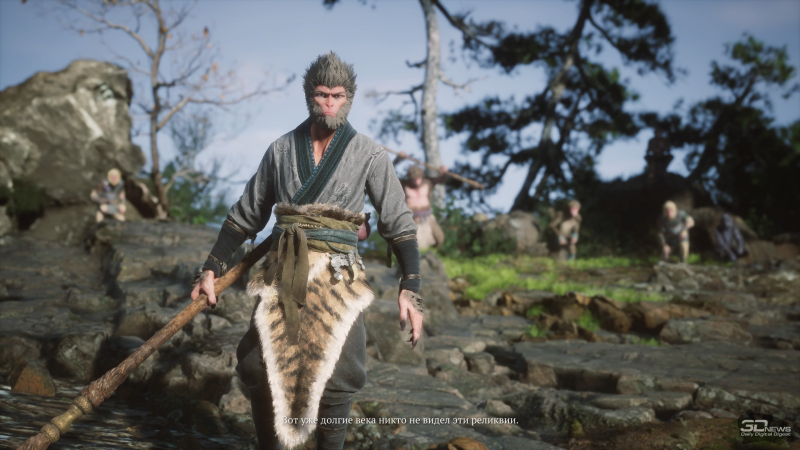
The main character is always serious and ready to fight
For those who know “Adventure to the West,” there are plenty of references here: there are familiar characters, and the protagonist can transform into anything, and he can summon a group of clones by pulling a hair out of his head. This is not a retelling, but fans of the original source will find a lot of pleasant little things. At the same time, an audience not familiar with the novel may not fully understand what is happening in the game. New terms constantly appear in dialogues, new characters are introduced into the story without explanation – and this applies to both heroes important to the plot, and bosses, and ordinary opponents. If, after defeating them, you go to the bestiary menu and read their descriptions, there can be whole stories there – like, for example, the story about a sword-bearing wolf who hid the treasure he found from the king, escaped punishment and became a captain. But there was no place for all this in the gameplay.
However, the main plot is clear, and the characters here are so likable that listening to the dialogue is interesting even without clarifying the backstory. For the most part, these are anthropomorphic animals: a drinking boar, a martial arts tiger, tail-beating dragons, overgrown rats. All are superbly drawn, animated and voiced, but even they are not as impressive as the scenery. The transition to Unreal Engine 5 has benefited the game – everything here looks amazingly realistic. From the dense jungle we go to the blinding hot desert, from there we are transported to a snowy location, where we will also have to ride a giant turtle, and so on. There are smeared textures, but this is rare.
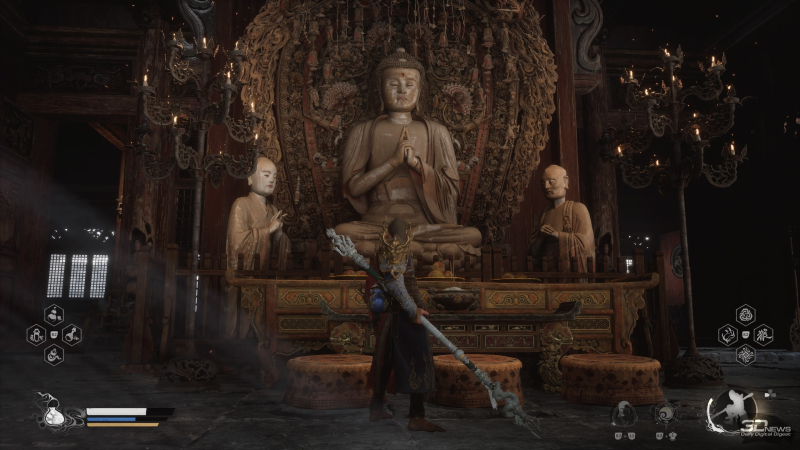
Religion was one of the central themes of Journey to the West, and it has not been forgotten here either.
The attention to detail never ceases to impress. Look at the wall in any temple and you will see small Buddhist figurines and beautiful frescoes. Stalagmites in caves are adjacent to bushes and trees growing through cracks. The bridges connecting the flimsy platforms are put together somehow from bamboo and are surprisingly strong. The folder with screenshots is growing at breakneck speed, and you don’t even need to be a fan of Chinese culture to enjoy every frame.
It’s doubly cool that not only the scenery turned out amazing – the staging of the cutscenes and battles is also luxurious. In terms of epicness, Black Myth: Wukong at its best moments is reminiscent of a modern God of War. Huge bosses smash stone statues, splashes of water fly in all directions if you fight someone in a body of water, and sometimes even the color palette changes – usually this happens when you take away half or a third of the boss’s health. Even quick descents along steep slopes were made spectacular: crossbowmen from different sides would start shooting with the accuracy of stormtroopers from Star Wars, or a dragon would fly overhead. Many moments are literally breathtaking.
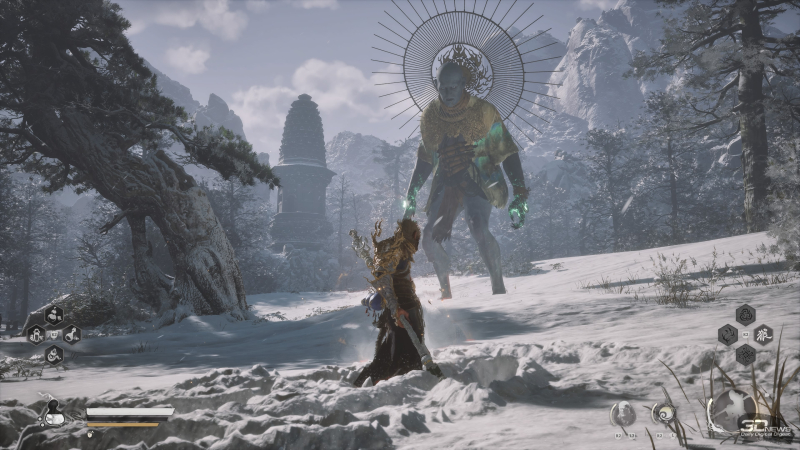
But this is not even the boss!
One thing spoils everything – invisible walls. They sometimes appear even in big-budget blockbusters, but in this game there are noticeably more of them than usual. The level designers either did not have enough experience or time – be that as it may, more than once you will run somewhere in full confidence that there is a passage there, but you will run into an invisible barrier and spend a couple of seconds trying to get around it. It’s not that it spoils the impression; rather, it just upsets me: I ran in vain, as it turns out.
In any case, there are plenty of secrets. Black Myth: Wukong has no map at all, and the further you progress through the game, the larger and more branched the regions become. At first, this is very annoying – you don’t know which way is better to go at a fork, you worry about missed “gatherers” and hidden bosses. But over time, I begin to like this approach more and more. It’s really interesting here to explore locations and find some valuables – either a resource needed to improve equipment, or a large enemy who will leave behind armor or materials for upgrading weapons. You’ll probably miss some useful things, but you’ll have a reason to return to the game when you find hints on the Internet – there are even side quests, and some of them make boss battles easier.
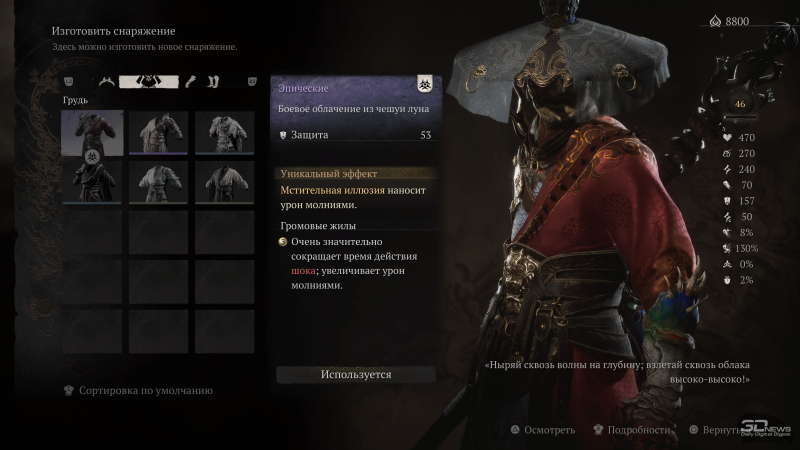
Armor gives bonuses to characteristics, and with sets of equipment there are even more useful “passives”
⇡#With one staff
We can talk about bosses for hours. These are dozens of unique opponents who surprise you with something new every time: they either rush around the entire arena, use spells, summon someone, or even turn into other creatures, including flying dragons. Some you win the first time, while others you get stuck for half an hour, including because they start using new skills when they are seriously wounded. It’s hard to remember frankly bad episodes, and this is impressive – the team, for which Black Myth: Wukong became the first large-scale AAA game, came up with almost a hundred excellent bosses on the first try, among which there are very few passable or unsuccessful ones.
There is only one weapon – a staff for close combat, but you don’t get tired of using it, even though the hero doesn’t learn new techniques. Initially, three fighting stances are unlocked, differing only in strong attacks. Regular attacks remain the same, and with their help you accumulate concentration points, which you can spend at any time on especially powerful attacks (even in the middle of a combo). Interestingly, there is no parry button, which is usual for action games – in Black Myth: Wukong you can only dodge enemy attacks, which activates a beautiful time dilation every time. An enjoyable combat system rewards skillful use of the protagonist’s most important skill, once you learn the behavior of enemies and start dodging several attacks in a row.

The outcome is predictable
While staff hits and dodging are important, so is magic. The character unlocks spells gradually, and each of them turns out to be more powerful than the previous one. First, you learn to freeze your opponents – if the boss stands still for a few seconds, you can deal significant damage to him. Then you can summon a group of your clones – the opponents are not distracted by them, but they receive severe wounds. A spell that makes the protagonist invisible is also useful – when used, a decoy figure is created on the ground, very similar to the main character. If you expect the enemy to launch a powerful combination of attacks, you can activate this ability and let him beat the air. There will be a lot more magic, but the most interesting one is the ability to turn into stone for a second. This is a kind of parry, since when hitting a stone, the enemy is usually stunned for a short time, and his series of attacks is interrupted. But it costs mana, so it’s unlikely that you’ll be able to use it throughout the entire boss fight.
Much of the above can be improved by spending experience points: unlocking new features of stances (for example, your combo will no longer be interrupted when activating a somersault), pumping up magic, and simply improving characteristics such as stamina and health. You can also develop transformations – like Sun Wukong in the famous novel, our hero is able to take on the guise of other fighters and spirits. In the case of fighters, you become someone else for a few seconds and use someone else’s techniques – the health bar for transformations is separate, so this allows you to deal serious damage and saves first aid kits. With spirits it’s even simpler – by pressing two buttons, you turn into someone for a split second and use a powerful skill: rush at the enemy in the form of a wolf, release a stunning arrow, shoot lightning from a staff, and so on. All spirits can also be upgraded by improving the passive skills that they temporarily bestow on the protagonist after contacting them.
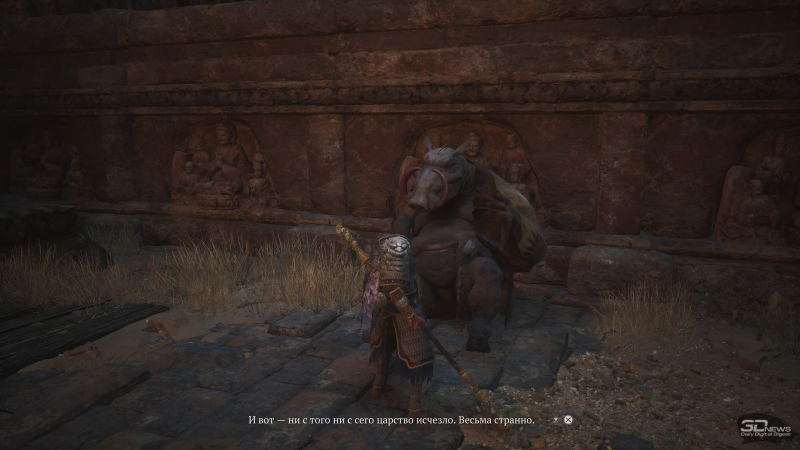
The characters don’t like to talk a lot, and the player doesn’t have to choose his lines
In general, there are a lot of opportunities for leveling up here, but there won’t be enough experience points for everything. Fortunately, the developers did not limit players – at any time you can reset everything and try a different path of character development. There is no need to explain how wonderful this option is – for example, if some stance in the middle of the passage seemed more convenient to you than the previous one, you can quickly transfer all the experience points to leveling it up and try something new. Or if your investment in health did not pay off and you realized how powerful magic is, nothing will prevent you from redistributing points into improving spells.
And most importantly, your experience and all accumulated points do not disappear anywhere after death, so there is always a sense of progress, even if you are stuck on some boss and die over and over again from his hand (claw/paw/magic). Before the release of Black Myth: Wukong, they were mistakenly compared to soulslices – there are analogues of bonfires, when interacting with them, enemies are revived, and it is easy to die from bosses. But in fact, the game’s structure is more reminiscent of Star Wars Jedi: Fallen Order – it’s not soulsliking in the usual form, but an action game inspired by soulsliking. It can indeed be quite difficult, especially when you fight the final bosses of each chapter, but in most cases it takes no more than three attempts to win – if you use magic wisely, dodge attacks and remember what combinations of attacks and techniques your opponents use.
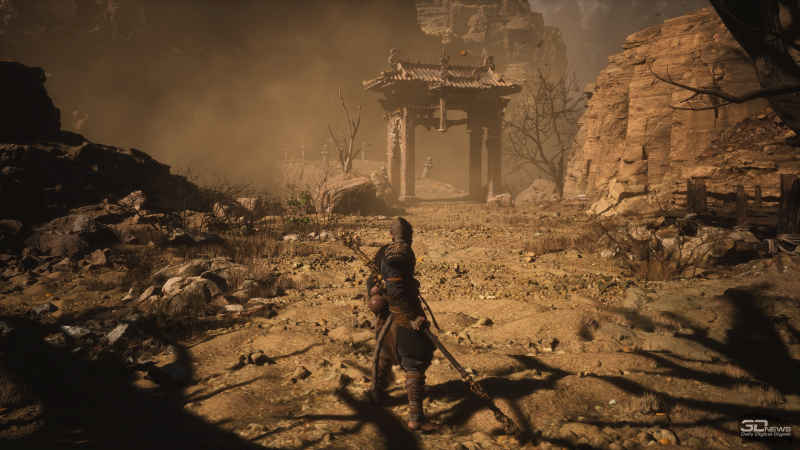
It’s hard to choose screenshots – one is more beautiful than the other
***
Black Myth: Wukong is impressive – you don’t even have to make allowances for the fact that this is the first high-budget release for the team. Almost everything here is done masterfully: the graphics are phenomenal, the locations are varied, the battles are exciting, and the bosses are excellent. The plot turned out to be not the most accessible for Western audiences, and the invisible walls cause either laughter or irritation, but these are such trifles against the background of everything else that I don’t even want to focus on it. If many people previously associated the Chinese gaming industry with mobile gachas (which, by the way, can be very good), now they will take it much more seriously. I would like to believe that this game will not only inspire other Chinese developers, but also mark the beginning of a new series – the sequel will immediately become one of the most anticipated games, and not only in China.
Advantages:
- Gorgeous scenery painted with amazing attention to detail;
- Spectacular and exciting battles with dozens of unique bosses;
- Fun combat system with different stances, spells and dodges;
- Accumulated experience is not lost in case of death, and points spent on leveling up can always be redistributed;
- Many secrets, including hidden locations and side quests.
Disadvantages:
- If you do not know the source and are not immersed in the culture, the story will not be fully understood;
- There are a lot of invisible walls – the further you progress through the game, the more there are.
Graphic arts
Visually, Black Myth: Wukong is impressive from the first frame, and the graphics only get better from there.
Sound
I am ready to run around such locations to the sounds of bamboo flutes forever. The actors also did an excellent job – both in the English and even more so in the Chinese versions.
Single player game
Six chapters, each of which seems cooler than the previous one – everywhere there are beautiful locations, great bosses and new gameplay features that make the gameplay more fun and varied.
Estimated time of completion
40 hours for a normal walkthrough and another 20 hours for searching for unfinished bosses and secrets.
Collective game
Not foreseen.
General impression
An action game with the structure of Jedi: Fallen Order, the epicness of modern God of War and complexity close to soulslices. A great project with minor rough edges and one of the best games of the year.
Rating: 9.0 / 10
More about grading system
Video: